One of the most frequently asked questions I get here is, “Can I grow XYZ in a pot?” My answer is usually the same, which is to say you can grow just about anything in a pot. Just as long as its the right sized container. And if you are prepared for the extra work of delivering everything the plant needs. (From food to water to light to air circulation.) With spring on the horizon (more distant for others, I know), I thought I would give you a few tips. Here's how to grow this joyful spring bloomer in a container.
Rhodies are lovely evergreen shrubs that comes to life in spring with huge trusses of blooms. They're such a gift that keeps on giving to the sequence of bloom that we all want in our gardens. Once the show is over, rhodies tend to fade into the background, becoming a loose, but still stately green presence. In containers, they're just about as much billowing color and happy form as you can hope for in early spring. As the season progresses, they become a useful foil when you surround them with other potted specimens.
Soil, light, food notwithstanding (see below), the trick to successfully growing a rhododendron in a container. Choose a compact, smaller sized plant that will adapt well to the confines of a fairly large pot. Choose a dwarf variety that thrives in your climate for the best results—try to keep within 3 to 5 feet in height. You could, of course, plant yourself a 7-footer in a really huge pot. Maintaining it would be quite the commitment! Being a container will restrict the size of your rhodie. However, you can further keep it to a manageable size with pruning (also see below).
If you’re interested in trying to grow a rhodie in a pot, here are 10 we recommend.
This Rhododendron looks beautiful anywhere in the landscape. Its size and showy coloring make it perfect for a large pot set where you can really appreciate it. With its showy soft pink flowers with darker pink margin and a dark red blotch on each upper petal. Full to partial shade. Up to 4 ft. tall and wide. Zone: 5 – 9
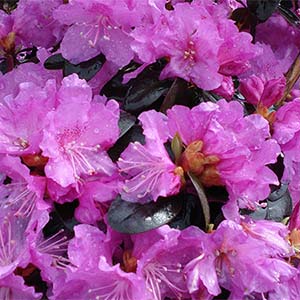
P.J.M. Rhododendron
Zone: 4 – 8
Super hardy variety noted for its tolerance for heat as well as cold. The foliage takes on a mahogany-brown winter color. Partial sun. Up to 3 ft. tall and 5 ft. wide.

Chionoides Rhododendron
Zone: 5 – 9
Compact, dense form is wider than tall. It's perfect in a space you need to fill with lush, mid-to-late spring color. Partial shade to full sun. Up to 4 ft. tall and 6 ft. wide.
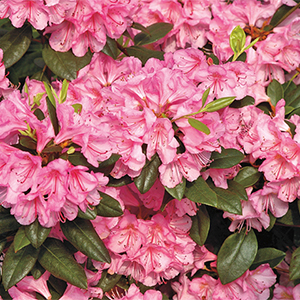
Bubblegum Rhododendron
Zone: 5 – 8
Trusses of lightly-scented flowers explode in spring, offset by showy reddish stems. Low and compact–perfect for pots. Partial sun. Up to 3 ft. tall and wide.
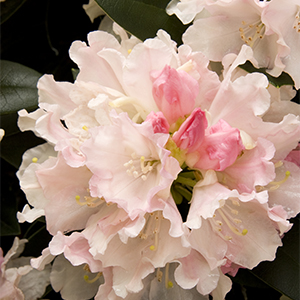
Dreamland Rhododendron
Zone: 6 – 9
Pretty and romantic with pale-pink flowers that look so good in contrast to a terra cotta pot. Partial shade to partial sun. Up to 4 ft. tall and wide.
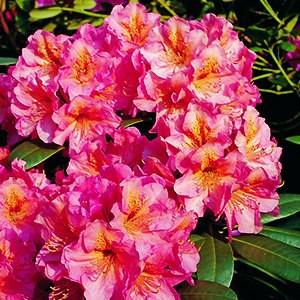
Miyama™ Dolcemente Rhododendron
Zone: 6 – 9
Ruffly stunner does get larger than others, but performs so well in warmer zones, we had to include it. Partial shade to full sun. Up to 4 ft. tall and 5 ft. wide.
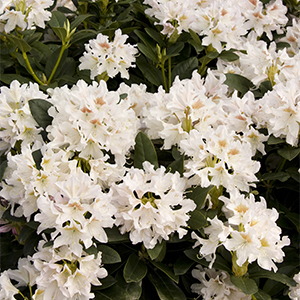
Cunningham’s White Rhododendron
Zone: 5 – 8
It’s smallish and rounded form means it’ll look very elegant spilling over the sides of a container. Partial shade to partial sun. Up to 4 ft. tall and wide.

Sugar Puff Rhododendron
Zone: 5 – 9
Semi-dwarf small leaf rhododendron with tan buds that open to cotton candy blooms. Super prolific and more heat tolerant. Partial sun. Up to 3 ft. tall and wide.
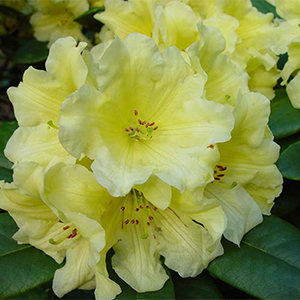
Hotei Rhododendron
Zone: 6 – 9
Compact and dense this one’s highly valued for its large ball-shaped trusses of beautiful, canary yellow flowers. Partial sun. Up to 3 ft. tall and wide.
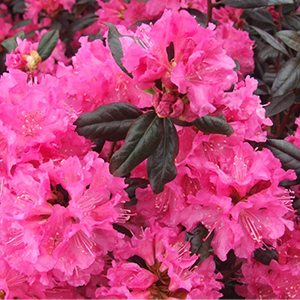
Landmark Rhododendron
Zone: 5 – 8
Compact bloomer produces showy deep fuchsia-pink flowers with a faint scarlet spotting. More sun tolerant than other rhodies. Partial sun. Up to 4 ft. tall and wide.
So, break it down for me…
- Choose correct containers: To get the right sized pot, select one that's about one-third larger than the original nursery container. You want a pot that's large enough to allow the plant to root in beautifully. However, not so large that you might end up overwatering. Rhodies can be shallow rooted, especially when young–if possible select a pot that’s wider than taller.
- Drainage is the word: Rhodies need great drainage. They can fail to thrive if soil is too wet or if the pot sits in a pool of water in a saucer. can often fail when grown in pots due to poor drainage. Look for lots of drainage holes in your container. Using pot feet allows air to circulate under the pot which is never a bad thing.
- Bag soil for acid lovers: Regular potting soil doesn’t have the acidic pH that rhodies prefer. Opt instead for soil specially formulated for azaleas or conifers.
- Plant high: (Not you! The plant.) Plant so that the top of the root ball is about one inch above the soil level. This improves drainage and aeration around the root ball. Top exposed root ball with a thin layer of compost, shredded leaves or mulch around the base of the plant. This will help lock-in moisture. Reapply as this layer becomes depleted.
- Pruning: Prune right after the rhodie has finished blooming as shrubs make blooms that flower on the prior year’s wood. Buds for next spring will be made this summer, and you don’t want to prune those off. Small-leafed rhododendrons (which we’ve listed) can be pruned anywhere along their stems. Prune spent blooms, dead or weak limbs, and limbs that are crossing. If the plant gets too large, prune back by 1/3-1/2 of the overall size. Know that this can stop the plant from flowering for a year or two.
- Ongoing: Water containers thoroughly when the soil feels dry to the touch. Feed with fertilizer formulated for acid-lovers such as Holly Tone every spring to help encourage growth. If necessary, prune right after the shrub has finished blooming. Repot with fresh soil every 2 years.
Image Credits:
Lead image: DK – Grow Plants in Pots, 2011 Dorling Kindersley Limited




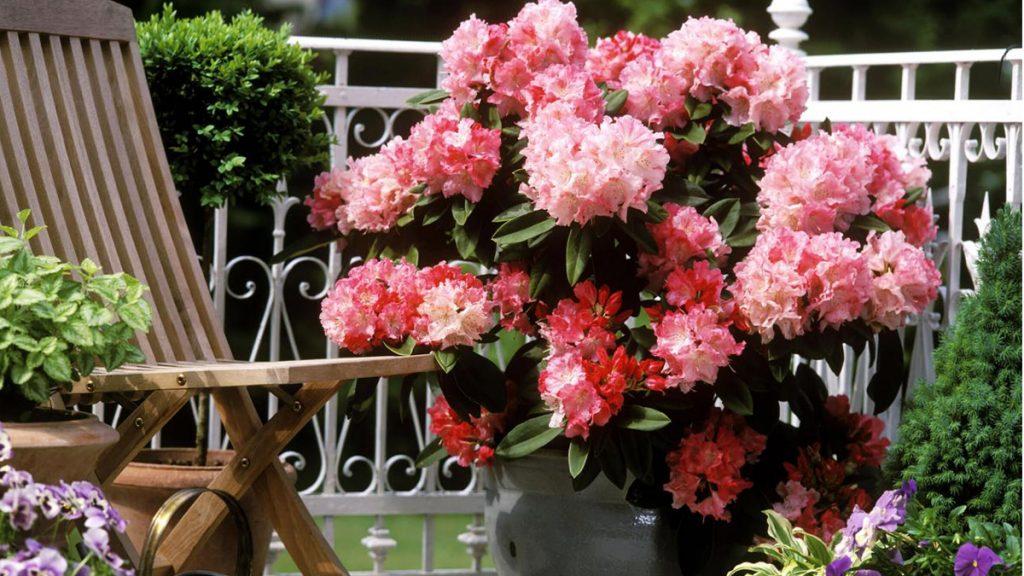
Please login to comment.
Don't have an account?
Sign Up for free